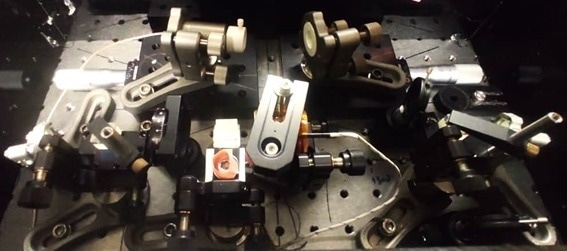Quantum entanglement, which happens when two or more systems are created or interact in such a way that the quantum states of some cannot be described independently of the quantum states of others, is a subject of increasing interest to scientists. Even when the systems are far apart, they are still correlated.

The optical parametric oscillator (OPO) used in the study. Image Credit: Alvaro Montaña Guerrero, a member of the team led by Hans Marin Florez and the first author of the article published in Physical Review Letters
Due to the significant potential for applications in encryption, communications, and quantum computing, this type of phenomenon is of research interest. The problem is that the systems almost instantly detangle when they interact with their environment.
In the most recent research, scientists from Brazil’s Laboratory for Coherent Manipulation of Atoms and Light (LMCAL) at the University of SãoPaulo’s Physics Institute (IF-USP) were successful in creating a light source that generated two entangled light beams. The journal Physical Review Letters has an article about the study.
This light source was an optical parametric oscillator, or OPO, which is typically made up of a non-linear optical response crystal between two mirrors forming an optical cavity. When a bright green beam shines on the apparatus, the crystal-mirror dynamics produces two light beams with quantum correlations.
Hans Marin Florez, Study Last Author and Physicist, Physics Institute, University of São Paulo
The issue is that because the wavelength of the light emitted by crystal-based OPOs differs from that of the systems in question, such as cold atoms, ions, or chips, it cannot interact with other systems that are relevant to quantum information.
Florez added, “Our group showed in previous work that atoms themselves could be used as a medium instead of a crystal. We therefore produced the first OPO based on rubidium atoms, in which two beams were intensely quantum-correlated, and obtained a source that could interact with other systems with the potential to serve as quantum memory, such as cold atoms.”
This did not, however, prove that the beams were intertwined. To show quantum correlations, the beams’ phases, which have to do with light wave synchronization, were also necessary.
“That is precisely what we achieved in the new study reported in Physical Review Letters. We repeated the same experiment but added new detection steps that enabled us to measure the quantum correlations in the amplitudes and phases of the fields generated”, Florez further stated.
He added, “As a result, we were able to show they were entangled. Furthermore, the detection technique enabled us to observe that the entanglement structure was richer than would typically be characterized. Instead of two adjacent bands of the spectrum being entangled, what we had actually produced was a system comprising four entangled spectral bands.”
In this instance, the wave amplitudes and phases were mixed up. This is fundamental to many protocols used to process and transmit information that has been quantum-coded. In addition to these potential uses, this kind of light source could also be employed in metrology.
“Quantum correlations of intensity result in a considerable reduction of intensity fluctuations, which can enhance the sensitivity of optical sensors. Imagine a party where everyone is talking and you can’t hear someone on the other side of the room. If the noise decreases sufficiently, if everyone stops talking, you can hear what someone says from a good distance away,” Florez further added.
One of the potential applications, he added, is boosting the sensitivity of atomic magnetometers used to gauge the alpha waves produced by the human brain.
FAPESP provided funding for the study through a Thematic Project directed by Professor Marcelo Martinelli of IF-USP, one postdoctoral scholarship awarded to Florez and two Ph.D. scholarships awarded to the first author of the study, lvaro Montaa Gerreiro, and Raul Leonardo Rincon Celis.
Additionally, the article highlights the benefit of rubidium OPOs over crystal OPOs.
Florez noted, “Crystal OPOs have to have mirrors that keep the light inside the cavity for longer, so that the interaction produces quantum correlated beams, whereas the use of an atomic medium in which the two beams are produced more efficiently than with crystals avoids the need for mirrors to imprison the light for such a long time.”
Other teams had attempted to create OPOs using atoms before his team did, but they had been unable to show quantum correlations in the light beams they generated. The results of the new experiment demonstrated that there was no systemic limit that would have prevented this.
Florez further stated, “We discovered that the temperature of the atoms is key to observation of quantum correlations. Apparently, the other studies used higher temperatures that prevented the researchers from observing correlations.”
Journal Reference
Guerrero, A. M., et al. (2022) Continuous Variable Entanglement in an Optical Parametric Oscillator Based on a Nondegenerate Four Wave Mixing Process in Hot Alkali Atoms. Physical Review Letters. doi:10.1103/PhysRevLett.129.163601.